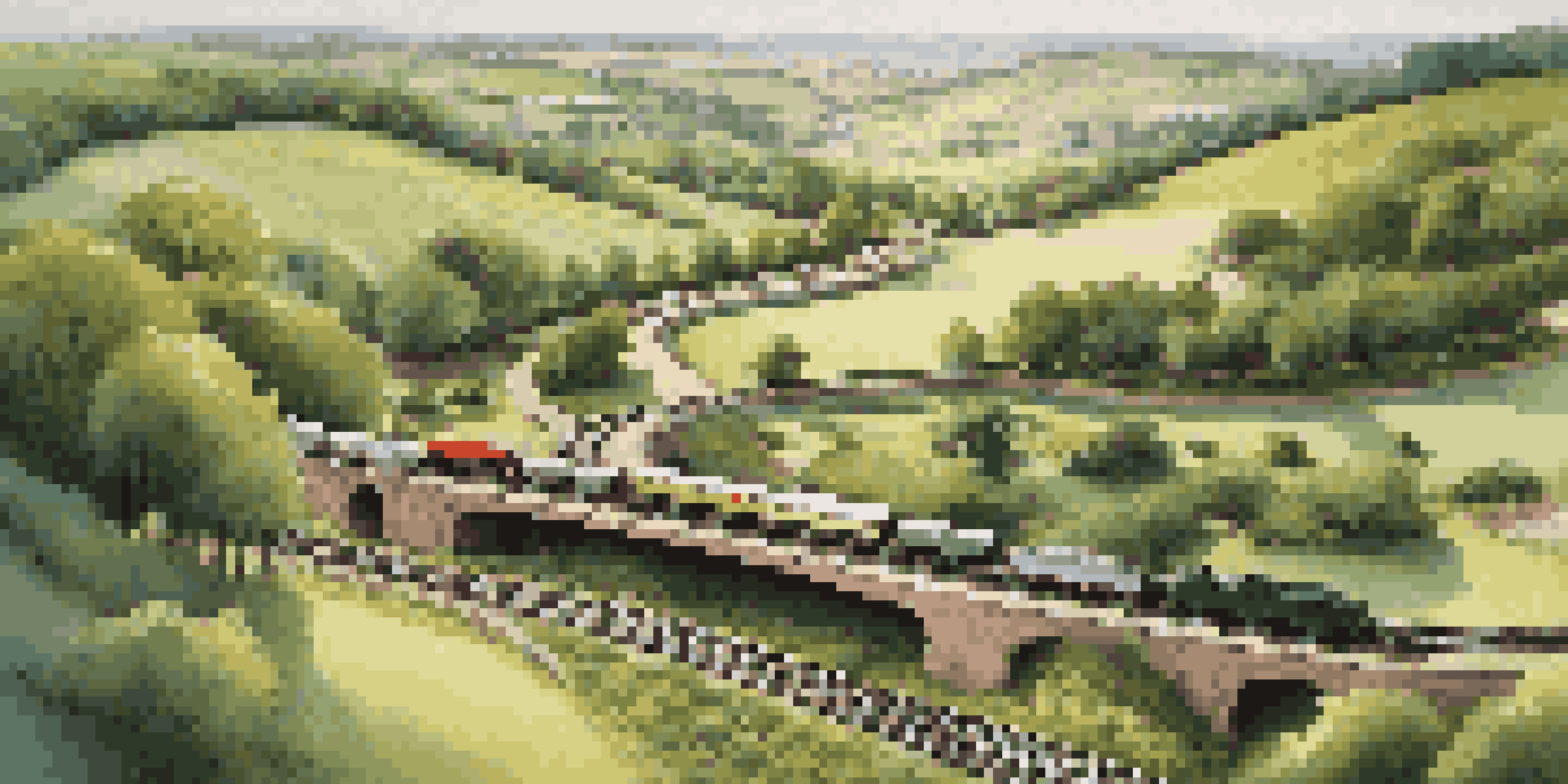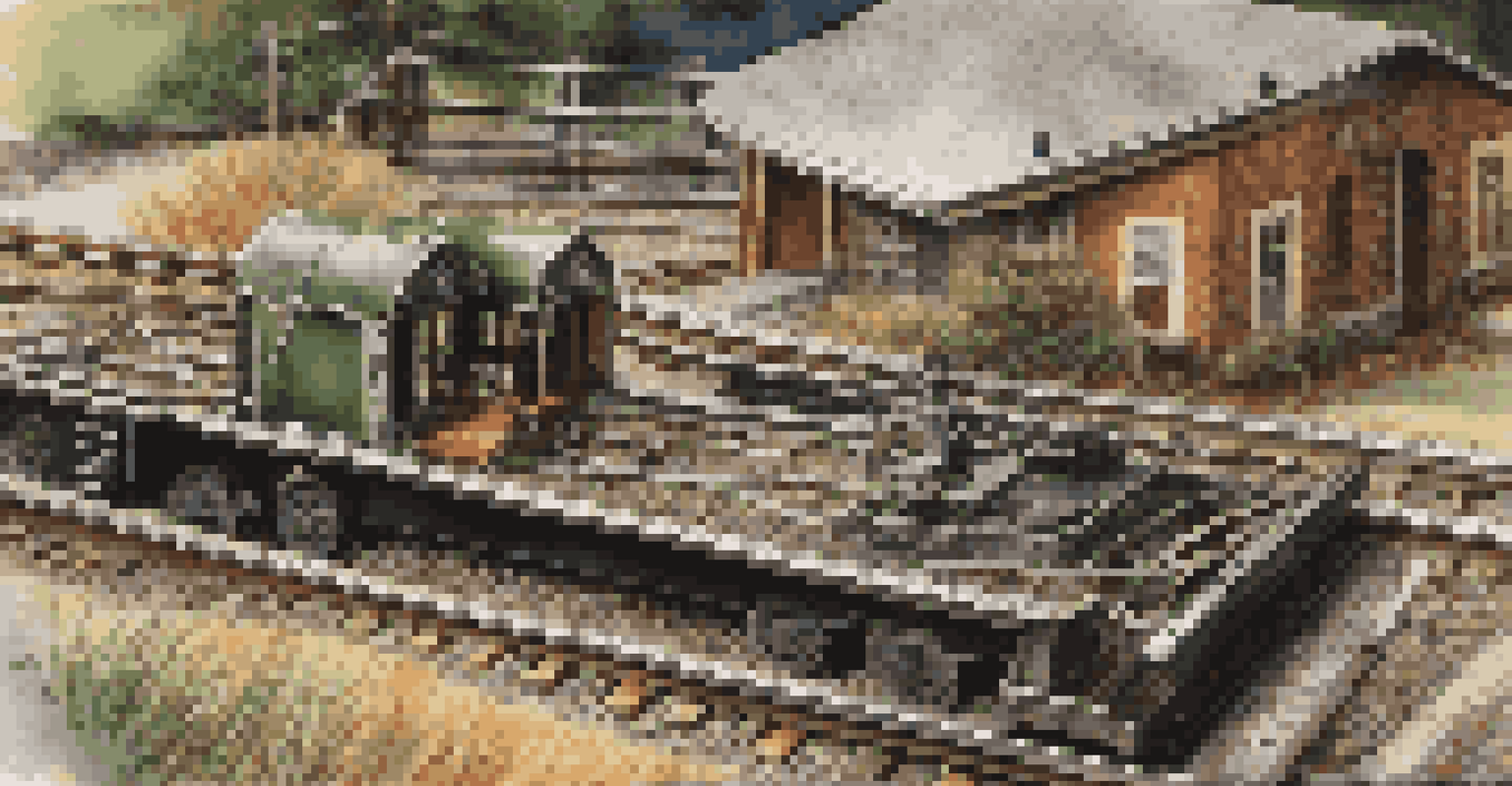Exploring Various Track Types for Model Railroads

Understanding the Basics of Model Railroad Tracks
Model railroads are a fantastic hobby that allows enthusiasts to recreate real-world rail systems. One of the most crucial components of this hobby is the track, which comes in various types and sizes. Understanding these basics can help you build a more realistic and enjoyable layout.
Life is like a train journey. You can choose the tracks you want to follow, but the destination is up to you.
The primary function of railroad tracks is to guide trains safely across your layout, and their design plays a significant role in achieving this. Tracks can vary in gauge, which is the distance between the rails; common gauges include 1:87 (HO scale) and 1:160 (N scale). Knowing the correct gauge for your model can make a significant difference in how well your trains run.
Moreover, the type of track you choose can influence the overall aesthetic of your layout. From modern, shiny tracks to rustic, weathered ones, each type can evoke a different time period and atmosphere, enhancing the storytelling aspect of your model railroad.
The Popularity of Straight Tracks in Layouts
Straight tracks are the backbone of most model railroad layouts, providing essential segments for trains to gain speed and navigate smoothly. They are straightforward to install and can be easily connected to other types of track, making them a favorite among beginners and experienced hobbyists alike. Their simplicity is a key reason why many modelers start with straight tracks.

One of the best things about straight tracks is their versatility. They can be used in various configurations, whether you're creating a yard, a mainline, or simply connecting loops. This flexibility allows you to customize your layout to fit the space you have available while maintaining a clean, organized appearance.
Importance of Track Types
Choosing the right type of track, whether straight, curved, or flexible, significantly impacts the realism and functionality of your model railroad.
Furthermore, straight tracks allow for easy maintenance, which is vital for keeping your trains running smoothly. Since they have fewer curves and joints, there are fewer opportunities for derailments, making them a reliable choice for your model railroad.
Curved Tracks: Adding Dynamics to Your Layout
Curved tracks are essential for creating realistic and visually appealing model railroads. They help simulate the natural bends found in real railway lines, adding a level of dynamism to your layout. Incorporating curves can also make your trains appear more lifelike as they navigate through your scenes.
The journey of a thousand miles begins with one step.
When using curved tracks, it’s important to consider the radius, which affects how well your trains can navigate bends without derailing. Larger radii are preferable for longer trains and more intricate designs, allowing for smoother transitions. It's a bit like choosing the right path for a winding road; the smoother the curve, the better the journey.
Incorporating curves can also enhance the storytelling aspect of your model railroad. For instance, a train rounding a bend can reveal hidden scenery, creating a sense of discovery that flat layouts can't provide. This element of surprise can engage viewers and create an immersive experience.
The Role of Switches and Turnouts in Model Railroads
Switches and turnouts are vital components of model railroads, allowing trains to change tracks and navigate complex layouts. These elements add an additional layer of functionality, enabling you to create intricate routes and enhance the operational experience of your railroad. Think of them as the intersections on a city road, directing traffic where it needs to go.
When planning your layout, consider how many switches you’ll need based on the complexity of your design. More switches can lead to a more engaging and interactive experience, allowing trains to perform various maneuvers. However, keep in mind that they require regular maintenance to ensure smooth operation.
Role of Switches and Flex Track
Incorporating switches and flex track enhances the complexity and visual appeal of layouts, allowing for smoother transitions and creative designs.
Incorporating switches can also enhance the flow of your model trains. By strategically placing them, you can create multiple routes, allowing for a more dynamic experience as trains navigate your layout. This versatility can turn your model railroad into a bustling hub of activity.
Exploring the Benefits of Flex Track
Flex track is a popular choice among model railroaders for its adaptability and ease of use. Unlike traditional sectional tracks, flex track can be bent and shaped to fit the unique contours of your layout. This flexibility allows for more creative freedom, helping you bring your vision to life without the constraints of fixed lengths.
One of the key advantages of flex track is its ability to create smooth, flowing curves that enhance the realism of your model railroad. By avoiding the abrupt changes in direction found in sectional tracks, flex track allows trains to transition more naturally. Picture a river weaving through a landscape; the gentle bends are much more visually appealing than sharp angles.
Additionally, flex track is often easier to install, as you can cut it to the desired length. This means you can customize your layout with precision, making adjustments as needed without the hassle of dealing with multiple sections. It's a game-changer for those looking to experiment with their designs.
Understanding the Different Materials Used for Tracks
Model railroad tracks come in various materials, each offering unique benefits and challenges. The most common materials are plastic, brass, and nickel-silver. Plastic tracks are often the most affordable option for beginners, but they may not provide the same level of conductivity or durability as metal tracks.
Brass tracks are known for their excellent conductivity, which can lead to better performance for your trains. However, they are prone to tarnishing, which can affect their appearance and functionality over time. It's a bit like owning a vintage car; while they look fantastic, they require regular upkeep to keep them running smoothly.
Materials Matter for Performance
Understanding the different materials used for tracks, such as plastic, brass, and nickel-silver, helps modelers make informed decisions for optimal performance.
Nickel-silver tracks offer a great compromise between performance and maintenance. They resist tarnishing better than brass while still providing good conductivity. Understanding the pros and cons of each material can help you make informed decisions when selecting the right track for your model railroad.
Electrifying Your Layout with Power Tracks
Power tracks are a crucial element for model railroaders looking to electrify their layouts. These tracks can supply power to the trains, ensuring smooth operation and minimizing interruptions during play. It’s the equivalent of wiring a home; without it, everything comes to a standstill.
Using power tracks can enhance the experience by allowing for features like sound and lighting in your trains. Many modern locomotives come equipped with lights and sound systems that can make your layout feel alive. Imagine the thrill of watching a train pass by with its headlights illuminating the surrounding scenery.

When integrating power tracks into your layout, it's essential to plan the placement carefully. Poorly positioned power tracks can lead to dead spots, where trains may stall or lose power. Thoughtful planning ensures a seamless experience, allowing you to focus on enjoying your model railroad.
Final Thoughts on Choosing the Right Track Type
Choosing the right track type for your model railroad can be both exciting and daunting. With so many options available, it's crucial to consider your layout's design, your budget, and your personal preferences. Each track type offers unique benefits, and finding the right mix can enhance your overall experience.
Think about the story you want to tell with your model railroad. The tracks you choose can help convey different themes, whether it's a bustling city scene or a serene countryside. Just as a good book draws readers in, a well-designed track can captivate your audience and create a memorable experience.
Ultimately, the best track type is the one that aligns with your vision and brings you joy. Whether you prefer the simplicity of straight tracks or the complexity of switches, the key is to enjoy the creative process and let your imagination guide you.